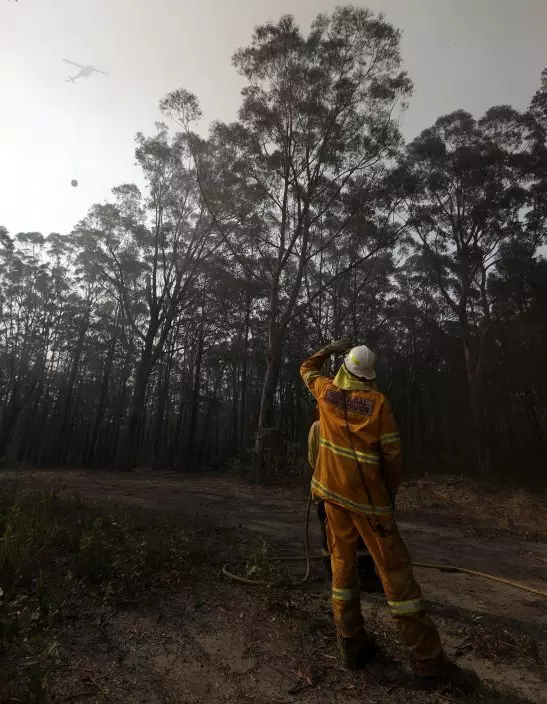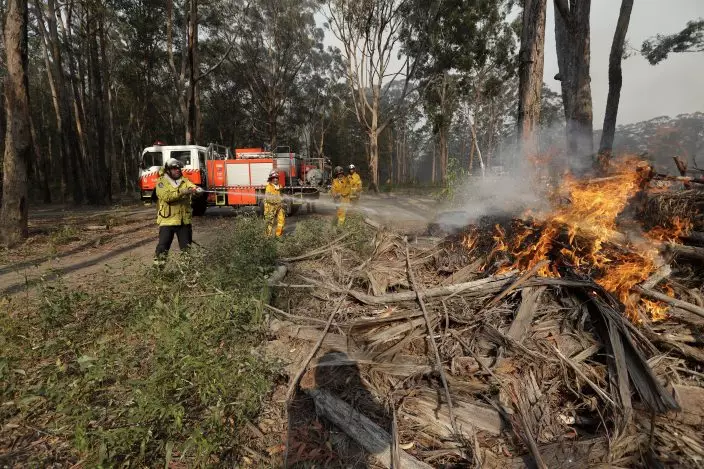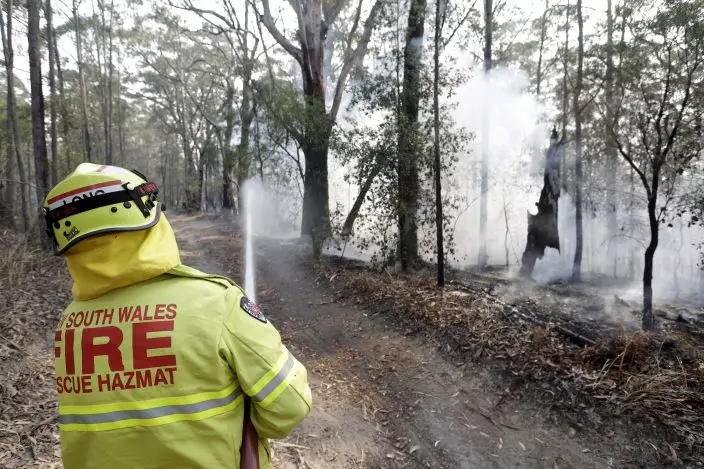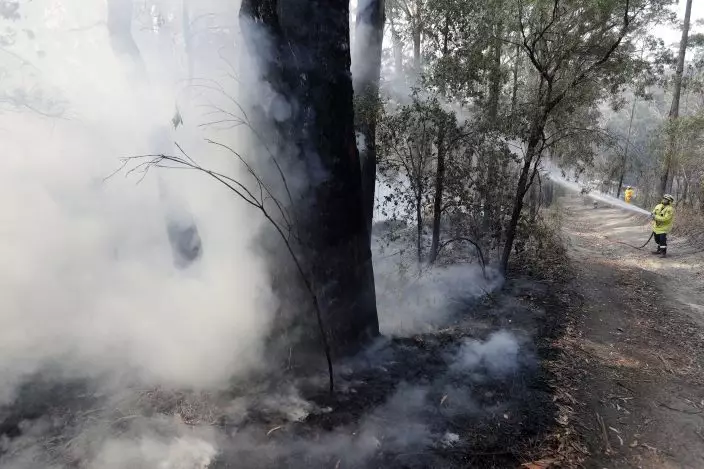Australia was bracing for one of the worst days in its wildfire crisis Saturday as strong winds and high temperatures were forecast to bring flames to more populated areas, including the suburbs of Sydney.
New South Wales Premier Gladys Berejiklian said her state is facing "another terrible day" and called on people in areas threatened by the fires to leave while they can.
"I'm pleased to say that we've never been as prepared as we are today for the onslaught we're likely to face," Berejiklian told reporters at a news conference Saturday morning. "All of the major road networks are still open but we can't guarantee that beyond the next few hours. So there are still windows for people to get out."

A firefighter watches a water bombing helicopter approach as they battle a fire near Bendalong, Australia, Friday, Jan. 3, 2020. Navy ships plucked hundreds of people from beaches and tens of thousands were urged to flee before hot, windy weather worsens Australia's devastating wildfires. (AP PhotoRick Rycroft)
New South Wales Rural Fire Service Deputy Commissioner Rob Rogers warned the fires could move “frighteningly quick.” Embers carried by the wind had the potential to spark new fires or enlarge existing blazes.
"We are unfortunately very likely to lose homes but we will be very happy and call it a success if no lives are lost," he said.
Rural Fire Service Commissioner Shane Fizsimmons said the 264,000-hectare (652,000-acre) Green Wattle Creek fire in a national park west of Sydney had the potential to spread into Sydney's western suburbs.

Firefighters battles a fire near Bendalong, Australia, Friday, Jan. 3, 2020. Navy ships plucked hundreds of people from beaches and tens of thousands were urged to flee before hot, windy weather worsens Australia's devastating wildfires. (AP PhotoRick Rycroft)
"There is potential for the fire to break out, cross the (Warragamba) dam and move into the western suburbs of Sydney," he said. “That fire is burning. It has the potential to come out into more populated areas this afternoon.”
He said crews have been doing “extraordinary work” by setting controlled fires and using aircraft and machinery to try to keep the flames away.
Fitzsimmons called on residents and tourists in the path of the fires to evacuate as soon as possible.

A firefighter battles a fire near Bendalong, Australia, Friday, Jan. 3, 2020. Navy ships plucked hundreds of people from beaches and tens of thousands were urged to flee before hot, windy weather worsens Australia's devastating wildfires. (AP PhotoRick Rycroft)
"Our message has been to make sure you leave yesterday," he said. "Leaving it until today is cutting it fine. The sooner you make that decision the better and I would say do it now. Don't leave it any longer because the window will shrink and will shrink very quickly."
More than 130 fires are burning in New South Wales and at least half of those are out of control. Temperatures in parts of the state are expected to soar in the mid-40s Celsius (about 113 Fahrenheit) amid strong winds and low humidity.
A forecaster at the Bureau of Meteorology said conditions were already deteriorating Saturday morning.

Firefighter battle a fire near Bendalong, Australia, Friday, Jan. 3, 2020. Navy ships plucked hundreds of people from beaches and tens of thousands were urged to flee before hot, windy weather worsens Australia's devastating wildfires (AP PhotoRick Rycroft)
"We are getting high temperatures across most of (New South Wales), including Sydney as well as western and southern parts of the states, as predicted," he said.
A total of 48 fires are burning across almost 320,000 hectares (791,000 acres) in Victoria state and conditions are expected to worsen with a southerly wind change.
"We still have those dynamic and dangerous conditions, the low humidity, the strong winds and, what underpins that, the state is tinder dry," Victoria Emergency Services Commissioner Andrew Crisp said.

A firefighter battles a fire near Bendalong, Australia, Friday, Jan. 3, 2020. Navy ships plucked hundreds of people from beaches and tens of thousands were urged to flee before hot, windy weather worsens Australia's devastating wildfires. (AP PhotoRick Rycroft)
Thousands have already fled fire-threatened areas in Victoria and Crisp urged more people to leave.
"If you might be thinking about I can get out on a particular road close to you, well there's every chance that a fire could hit that particular road and you can't get out," he said.
Victoria police reported heavy traffic flows on major roads and praised motorists for their patient and orderly behavior.
A blaze on Kangaroo Island off the coast of South Australia was still uncontrolled Saturday, having destroyed homes and other buildings as it burned through more than 14,000 hectares (35,000 acres) of Flinders Chase National Park. While the warning level for the fire was reduced, the Country Fire Service said it was still a risk to lives and property.
The early and devastating start to Australia’s summer wildfires has already burned about 5 million hectares (12.35 million acres) of land, left at least 19 people dead, and destroyed more than 1,400 homes. That's more acres burned in Australia than any one year in the U.S. since Harry Truman was president.


